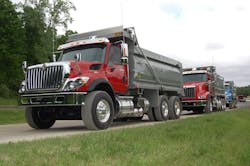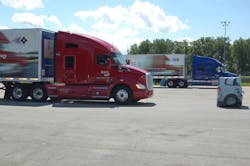A nearly 40-year veteran of the vehicle service industry, Jeff Schlump spent over 20 years at Tenneco handling heavy-duty account needs for Mack, Volvo, and Navistar truck owners, before moving on to a variety of parts providers focused on light vehicles. Now at Gabriel Ride Control, Schlump is back on the heavy-duty truck beat and below shares some insight into the value shock absorbers provide in terms of helping extend equipment life.
Heavy-duty trucks need ride control systems that can handle everything a driver can throw at it. A heavy-duty (HD) vehicle will travel many more miles in a year than the average car, and often over rough or uneven terrain. Depending on the specific application, an HD vehicle could be traveling frequently across off-road surfaces, through quarries or construction sites. To handle this treatment, the ride control systems in HD vehicles must be robust, durable, and long-lasting.
Not all driving is easy highway driving in commercial trucking. Many drivers are required to haul precarious loads over uneven surfaces, all across the country, in all kinds of weather conditions. These situations put extra strain on a vehicle’s ride control system that must be accounted for when designing and installing HD systems.
Rough and frequently changing surfaces make shocks work constantly to keep the vehicle steady. As a truck drives over more bumps and dips, the shocks work harder and wear faster. Although the road surface is the most obvious contributor, a truck’s load affects its ride control system as well.
A vehicle carrying shifting loads, like liquids or gravel, also puts unusual strain on its shocks. As the load shifts back and forth while driving, the shocks must continuously adjust to keep the vehicle steady.
Some fleet drivers need to carry loads such as these from one coast to another, passing through multiple different temperatures, moisture levels, and weather conditions in one trip.
Each of these parameters affects the performance of shocks and heavy-duty shocks need to be able to withstand the stress of heavy-duty applications with minimum downtime.
Unfortunately, shocks are an often overlooked component. But driving with bad or overly-worn shocks does more than just reduce the comfort of the ride. It leaves the rest of the vehicle vulnerable to vibrational damage. Under rougher driving conditions, shocks will experience more wear, and the longer and more often shocks are exposed to such conditions, the more likely it is that they will fail.
Not all shocks are built to handle the pressures of heavy-duty service. When shocks cannot adequately perform their job, the vibration from the road travels throughout the rest of the vehicle structure. This vibration can cause damage to all parts of the truck.
For example, vehicle lighting systems are not always able to handle excessive movement and extra vibration can cause them to crack or malfunction.
Another concern is delicate cargo, which can be harmed if the ride control system is not performing satisfactorily. Many vehicles today also have onboard electronic systems that can be harmed by excessive vibration.
Other vehicle systems, such as the braking system and tires can be negatively affected by bad shocks as well.
In terms of braking, whenever one applies a vehicle’s brakes, the body of the vehicle shifts forward with the momentum. The shocks compensate for this and help re-establish equilibrium. But if shocks begin to fail, the weight of the vehicle is thrown forward while braking and the brakes end up overworked and prematurely worn.
Similar problems happen with the vehicle’s tires. When shocks cannot control the movement of the suspension springs, the vibration from the road causes the tires to bounce and become unevenly worn.
Shocks are built to handle vibration and shield the rest of the vehicle from its effects. However, shocks that are not built with heavy-duty applications in mind will be worn down quickly, leaving the rest of the vehicle in jeopardy.
Thus, in order to handle the extra demands of heavy-duty driving, not just any shocks will do. Special consideration must be taken so that they can last for many years and miles while providing the best performance. Here are few items to consider:
- Chromed Piston Rods: By using super-finished chromed piston rods, corrosion, rust, and pitting of the rod will be greatly reduced. Any damage to the surface of the piston rod can tear the oil seal and cause oil to leak and the shock to eventually fail. Chrome protects the piston rod, and inevitably the seal, from damage, extending the life of the shock and increasing durability for HD driving.
- Hydraulic Stop: This can help prevent impact damage to trucks and components by creating a hydraulic “cushion” for the vehicle to ride upon. Absorbing extra energy, this feature protects axles, air springs, the shocks themselves and their mounts from unnecessary damage.
- Piston Seal: A leak-proof, self-compensating piston seal is more rugged and durable than the average seal. It continues to adjust over the life of the shock for consistent damping even in harsh conditions. This leads to longer life, greater protection, and consistent performance.
- End mount: It is common for end mounts that attach shocks to the vehicle to use a split eye ring and two-place spot welding to secure the shock. The end mounts that Gabriel makes uses a solid-steel eye ring with a 360 degree reinforced arc weld so that the material is fully and securely connected at all points of contact.
- Testing: Lastly, extensive testing on HD products ensures that they are truly ready to take on severe-conditions for the long-haul. We test HD shocks at every level of design and production for fit, durability, and on-road performance. In order to pass, products must perform for and withstand HD conditions over at least 200,000 miles.
Heavy-duty driving endures a host of trials and tribulations that the average vehicle does not encounter. Therefore, it is only right that the heavy-duty shocks are built and tested for the toughest and most demanding of conditions. Without the right shocks for the job, industries that rely on HD trucks would have to deal with the cost of frequent replacement and vibration-related damage.


